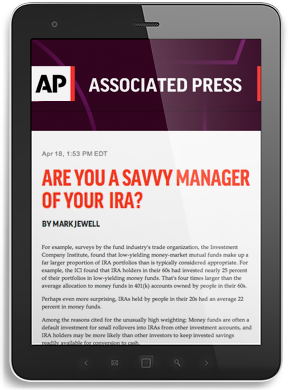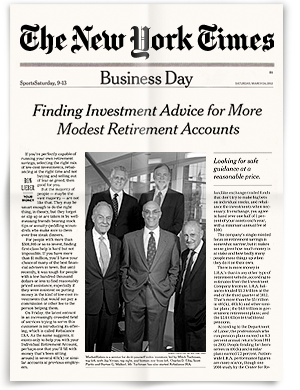The Folklore of Finance: Beliefs That Contribute to Investors’ Failure

When most people think of folklore, they think of ancient stories passed down through the ages. The tales may be instructive, amusing or both, but few take them as entirely true. Still, they represent an oral tradition that once helped people make sense of the world.
After a nearly two-year study that aimed to answer the question, What does true investment success look like?, Suzanne Duncan, global head of research at State Street’s Center for Applied Research, and her team found that the way individual and professional investors made investment decisions was so skewed that achieving both high returns and long-term objectives was nearly impossible.
They came up with a label for the beliefs that contributed to this failure: the folklore of finance. The study, to be released on Monday, found that people were overconfident in their investing ability, unable to focus on their stated long-term goals when distracted by short-term noise in the markets, and had come to distrust their advisers and lose interest in receiving professional investing help. It also found that changing these behaviors in individual and professional investors was going to be very difficult.
The study begins by trying to explain two very real disconnects in investing.
The first is part of the debate over skill versus luck in investing. Investors generally seek returns that beat a benchmark, known as alpha in financial jargon. But the reality is that alpha barely exists today — at least alpha that is achieved through skill and not luck.
In 1990, 14 percent of domestic equity mutual funds achieved “true” alpha — which was defined in a University of Maryland study as alpha that was not achieved by chance. In 2006, the number of funds delivering true alpha was down to 0.6 percent, which is statistically equivalent to zero. Five times as many funds operated in 2006 as in 1990.
Investors are not oblivious to the difficulty. Only 53 percent of individuals say they believe alpha is attainable by skill, while even fewer professionals, only 42 percent, attribute any performance above the benchmark to skill.
Why this has happened is a paradox of our age: Investors have both greater skill and more information to make outstanding performance more challenging. (The study includes an online quiz to test investing expertise). Think of it as standing up at a baseball game. If you do it alone, you have a better view. If everyone stands, only the tallest have a chance of seeing better than if everyone was still seated.
Yet the financial industry continues to search for alpha as if it were a great white whale. The study found that financial services firms spent 60 percent of their capital expenditures on resources to help generate short-term high performance. It is not for nothing: Active, as opposed to passive, money managers received $600 billion in fees in 2014, according to estimates State Street made from Boston Consulting Group’s Global Asset Management 2014 report. That amount is nearly equal to the gross domestic product of Switzerland.
The solution to the mostly futile quest for alpha, though, is not to switch to being a passive investor alone — which would mean investing in index-tracking funds that would return whatever the index returned, for a very low fee. Ms. Duncan called that reaction too simplistic. She advocated for a system at firm that would challenge broadly accepted, herdlike opinions.
What should be more achievable is setting a financial goal and meeting it, but the study found that this is not happening either. Individuals failing to stick to their plan is nothing new, but in some cases individual investors do not even understand what the plan is: 73 percent of respondents to a State Street survey said they invested with long-term goals in mind, including retiring comfortably and leaving an inheritance, but only 12 percent of those investors said they were confident they were prepared to meet those goals.
“Investors are very short-term-oriented in the sense of how the markets are performing,” Ms. Duncan said. “It’s all relative returns. That takes away from their ability to stay the course.”
In other words, if investors could focus on their long-term goals and understand that it is not going to be a straight line to get there, they would have a greater chance of achieving those goals. The study, of course, is not the first to look at these problems. The field of behavioral finance dates back to the 1970s. But the problems of chasing returns and failing to stick to the investment plan are attracting more attention. And the solution is often advisers who can spend more time finding out what their clients want to achieve and less on moving them among investments.
“It’s not very hard to help individuals realize what they want to do,” said Charles D. Ellis, founder of Greenwich Associates and a former chairman of Yale University’s investment committee. “It does take some time. You have to ask questions and find the answers that are acceptable.”
These go beyond return expectations, Mr. Ellis pointed out. They go to the core of person’s financial history, from how their parents fared financially to what they want their own money to accomplish.
The State Street study does not pull any punches in blaming the investment management industry for the pickle investors are in. It criticizes investment managers and advisers who are focused on short-term gains as a way of proving their worth. Fifty-four percent of institutional investors said they feared they could lose their job if they underperformed for only 18 months; 45 percent of people managing money at asset management firms said they felt the same.
“Career risk is much more profound than we anticipated,” Ms. Duncan said. “It’s difficult to change because it’s very much embedded in everything. It’s the culture, the fee structure, it’s based on assets under management, and they’re rewarded for this.”
Investors are starting to wise up to this game. A 2012 State Street study found that 65 percent of investors did not feel much loyalty to their investment adviser, while 93 percent of respondents to another State Street survey said they believed they would be better off investing on their own. After all, a CFA Institute study found that investors trusted the financial services industry less than they did the telecommunication, automotive, pharmaceutical and technology industries.
But investors’ taking investment decisions into their own hands has not proved to be the solution either.
The study found they look to markers like past performance or how others are doing to measure their own investment success, a false comfort in the study’s parlance. Only 29 percent of investors defined investing success as reaching their long-term goals; most preferred short-term markers, like their portfolio’s return versus that of a benchmark.
Another disconnect revolves around time. Investors want to invest with a long time horizon yet react to short-term swings that derail the strategy. Think of investment return markers, like one, three and five years — hardly the time needed to get people from their first job to retirement.
Yet these are at least conscious acts. People under the sway of what the study called the folklore of knowledge do not even realize how overconfidence, to take one example, is hurting their investment decisions.
“Are these myths? No, myths mean false,” Ms. Duncan said.
More to blame is people’s over-reliance on measures like mutual fund performance ratings, she said. “Morningstar gives us false comfort,” she said. “There’s some truth to Morningstar’s ratings. But there is untruth. Dart-throwing monkeys outperform market-cap-weighted indices.”
So what is to be done to change this?
One way the report suggests is to think of decision making — and the biases that derail it — as a boomerang. At the curved section of the boomerang, the study pointed to the most desired behaviors that professional investors and advisers could get their clients to embrace: an effective decision-making process, a realistic self-assessment, a tolerance for pain and goal ranking.
The clients would, ideally, avoid focusing on past performance, traditional benchmarks and looking to external sources of validation, like comparing your returns to your friend’s.
If advisers are going to help achieve those behavioral changes, they need to check in regularly with clients. “They need to make sure that their clients are on track with their long-term goals — something that could be difficult to do if advisers can’t correct their own behavioral biases,” Ms. Duncan said.
“We avoid seeing behavioral problems because it’s hard and painful,” she said. “One of our recommendations is to have a healthy pain tolerance.”






